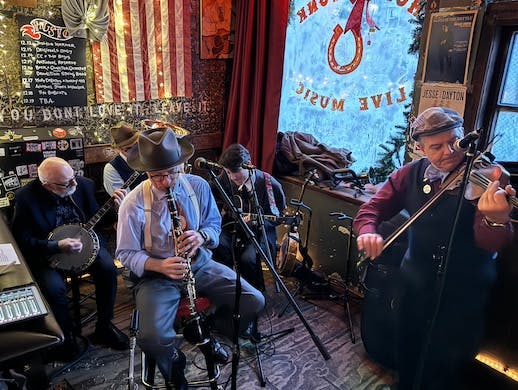Like the So-Called Territory Bands It Embraces, Buck and a Quarter Can Be Found All Over the Boroughs
Ensembles that during the 1920s and ’30s worked outside the few main metropolitan hubs have been categorized by jazz scholars as ‘territory bands.’ Buck and a Quarter embodies that ideal both musically and literally.

Buck and a Quarter
Brooklyn Firefly, February 10
Francis Kite Club, February 14
Barbes, February 21
The history of jazz has a distinctly metrocentric bias: During the 1920s and ’30s, we tell ourselves, the really important musicians played at New Orleans, Chicago, and New York; historians have only recently admitted that Kansas City belongs on this short list. Ensembles that worked outside those few central hubs have been categorized by scholars as “territory bands,” which is, at the very least, somewhat out of balance, in that said “territory” consists of most of these United States.
Trumpeter-composer Steven Bernstein has deliberately summoned the ideal of those groups with his Millennial Territory Orchestra, but for the last 10 years or so there’s another regularly working NYC collective that keeps the scrappy spirit of the territory bands alive. Buck and a Quarter embodies that ideal both musically and literally: Where the more upscale ensembles like the MTO and Vince Giordano’s Nighthawks play the mainstream clubs at Midtown Manhattan, like Dizzy’s and Birdland, this rough-and-ready assemblage can be found in bars and gin joints all over the boroughs, way out in Williamsburg and Park Slope and other neighborhoods less trendy.
Buck and a Quarter is sometimes referred to as the Buck and a Quarter Quartet, though there are usually five musicians; in my head, I keep thinking of them as the Buck and a Quarter String Band, as they are primarily guitars, banjos, and ukuleles. Plus, that name evokes the iconic 6 & 7/8s String Band, probably the most famous such ensemble in American jazz.
The group first came together as a trio of ukulele players — John Bianchi, Ben Mealer, and Angus Loten — in 2013, and were originally known as the Three-Quarter Quartet. Ten years ago, they added bassist and tuba player Brian Nalepka and violinist John “Scratchy” Landry, and Mr. Bianchi switched to reed instruments, clarinet, baritone saxophone, and the rare C melody saxophone. Messrs. Mealer and Loten now alternate between a myriad of guitars, banjos, ukuleles, and occasional percussion devices.
The group works an average of five gigs a month, and, depending on who’s available, you might see tuba-ist David Ostwald, or string players Mike Weatherly, Chris Bannon, Jack Morer, Ernie “Papa” Vega, or Bryce Edwards. Nearly all members of the collective sing, some more than others.
On a cold, rainy evening a few weekends ago, I made the trip out to Skinny Dennis, a bar on the corner of Berry Street and Metropolitan Avenue, to hear the band. There’s something about the cold weather that suits the area, and this saloon in particular. Everybody in Williamsburg already seems to dress like a lumberjack, and the winter atmosphere further enhances a decor that screams Alaska gold rush 1899. There were a couple of bearded young men in bulky flannel overcoats at the bar; I addressed them as “Yukon Jake” and “Klondike Pete.”
I couldn’t help but notice that the group’s first two songs were both tales of the rustic outdoors, “The Old Man of the Mountain” and “Roll Along, Prairie Moon.” As with string-centric bands in general, though the Buck and a Quarter is primarily a jazz group, there are close ties to early country and folk music styles.
The line-up that Saturday consisted of Messrs. Bianchi, Weatherly, Ostwald, Landry, and Edwards. The repertoire ranged from well-known jazz and songbook standards like “Everybody Loves My Baby” and “Nobody’s Sweetheart Now,” two songs that convey an inapposite message, to some numbers that haven’t been heard in 90 years, like “By Special Permission of the Copyright Owner.”
There’s even one song in their book that has never been recorded at all, “It’s Mating Time,” by J. Fred Coots and Haven Gillespie, the team that gave us “You Go to My Head” and “Santa Claus is Coming to Town.” For some reason, nobody made a record of it when it was published in 1935.
There also was exotica, like “The Valentino Tango” and “My Adobe Hacienda.” One surprise was “Douce Ambiance”; yes, it’s unique to hear the music of Django Reinhardt played on banjos, ukuleles, and tuba.
The band is a true collective; the individual members pick which tunes they want to play and sing — sometimes they seem to be trying to outdo each other in seeing who can pick the most obscure song. Mr. Landry usually sets the tempos, and Mr. Bianchi takes care of the bookings and organizational matters.
Buck and a Quarter plays with a lusty energy that counts for more than precision; this isn’t the John Kirby Sextet. It’s a fun band and they project an atmosphere of hilarity, especially in Skinny Dennis, where, though the room was packed, virtually no one was listening. Even so, their presence was most definitely felt, and those of us who were listening were very much enjoying ourselves.
Even so, announcing one tune, Mr. Bianchi got a major laugh when he informed the crowd, “We’re about to play a tune on two banjos. You don’t know how lucky you are — sometimes we have three banjos.”

